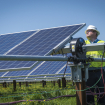Author: JULIAN SPECTOR
A cleantech startup announced this week that it has raised $50 million to scale distributed solar technology — but not for electricity production.
Zero Mass Water creates boxy solar panels that generate flows of pure, potable water instead of electrons. It offers access to safe water for homes or businesses in arid parts of the world or places with unsafe tap water. That need is set to grow as climate change dries out regions and alters weather patterns.
It’s no accident that Zero Mass Water follows the tactics and philosophy of the distributed solar market. Founder and MIT-trained materials scientist Cody Friesen previously started zinc-air battery company Fluidic, which supplied some 3,000 energy storage systems for remote renewable microgrids around the world. Billionaire Patrick Soon-Shiong bought that company and turned it into NantEnergy in 2018.
While traveling the world for Fluidic, particularly around Southeast Asia, Friesen noticed how water stress transcends geography. For his next venture, he wanted to “do for water what solar did for electricity,” he told Greentech Media. That vision attracted a high-powered roster of investors, bringing total funds raised to more than $100 million.TOP ARTICLES
 90% Clean Grid by 2035 Is Not Just Feasible, But Cheaper, Study Says
90% Clean Grid by 2035 Is Not Just Feasible, But Cheaper, Study Says NEC Pulls the Plug on Storage Integration Business
NEC Pulls the Plug on Storage Integration Business Loanpal Now No. 1 in the Booming Solar Loan Market
Loanpal Now No. 1 in the Booming Solar Loan Market
WHITE PAPERS
The Need and Opportunity to Enable Flexible Demand Response in the U.S.
Leveraging the Cloud for a Resilient, Secure, and Customer-Centric Utility
U.S. Solar Market Insight
Global solar PV operations & maintenance (O&M) 2020
“We’re accelerating from here,” Friesen said. “These are probably the last dollars in.”
In other words, this round should get the company to a place where it will need no further venture investment. The company has already commercialized its Source Hydropanels and has installed them for homes, schools, eco-resorts and other facilities in 45 countries. Zero Mass Water makes money on those deals at the project level, Friesen said, and is constantly honing the core technology to make it more cost-effective.
Zero Mass Water also created a “water purchase agreement,” equivalent to the power-purchase agreement that revolutionized the solar market by letting customers buy the output of plants but not the plants themselves.
Support from finance, utility sectors
Funds managed by BlackRock led the Series C round, months after CEO Larry Fink used his highly anticipated annual letter to warn that climate change was causing a “fundamental reshaping of finance” and promise to prioritize sustainability in investment decisions. Bill Gates-backed Breakthrough Energy Ventures and the Material Impact Fund joined the round, following up on earlier investments. U.S. utility Duke Energy also joined, a rare instance of that company making venture investments.
“Our objective with this investment is to support a sustainable solution — we know water is something every community needs and want to contribute to new solutions to deliver these vital resources to those in need,” spokesperson Catherine Butler said in an email.
Duke’s investment came from the corporate level, rather than from the regulated utility or the commercial development arm, she noted. The company previously made a direct venture investment in Omnidian, a solar operations and maintenance startup, and has invested in external VC funds.
The relationship with Zero Mass Water goes back several years to when Friesen met the late former Duke Chairman and CEO Jim Rogers at a Clinton Global Initiative event. Conversations there led to Duke supporting an early field deployment of the water panel technology in Guayaquil, Ecuador, where Duke operates a power plant.
How the Source Hydropanel works
The 340-pound Source Hydropanel contains a small photovoltaic array to power the system. The heart of the technology, though, is a set of nanomaterials designed to suck trace amounts of moisture out of the air — even in desert environments like the company’s home base of Tempe, Arizona. The panels use the heat of the sun’s rays to evaporate the water from the absorption materials. The system condenses the water, adds minerals to enhance the flavor and pipes it out for consumption.
A home installation of two Hydropanels in the U.S. costs between $5,500 and $6,500 for both equipment and installation labor, according to the company website. That system promises 12 bottles of “delicious water” per day for an operating life of 15 years, yielding a price of less than $0.15 per bottle.
Commercial-scale arrays string together rows of the same panel unit, much like solar PV panels scale up to supply commercial buildings. The company designs and assembles the panels in Arizona, then distributes them through a global network of installer partners, many of which come from the solar installation business.
The competitive landscape mirrors the solar power industry as well. The incumbent tool for generating fresh water in places where only salty water exists naturally is desalination. But desalination plants cost billions of dollars to build and consume vast amounts of energy in operation.
In contrast, Source Hydropanels produce drinkable water with no infrastructure upgrades required — such as building microgrids instead of a massive new thermal power plant.
Selling and installing Hydropanels, Friesen noted, is relatively simple compared to solar PV in terms of regulation and permitting. The friction associated with interconnecting to the existing electric utility network doesn’t really apply for self-contained water generators.





+ There are no comments
Add yours